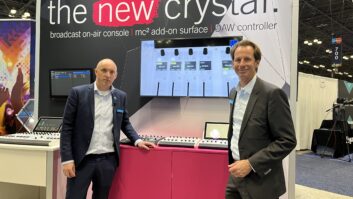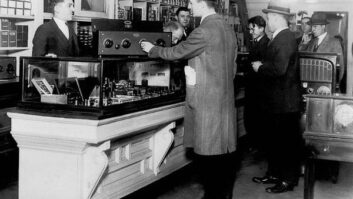“Rather than be a mile wide and an inch deep, we want to go the other way.”
So says Chris Pannell, recently promoted to director of North American radio sales at Harris Corp.’s Broadcast Communications Division.
I wrote last winter about the division’s direction under President Tim Thorsteinson; since then, there’s been more change in how Harris interacts with customers as it tries to expand into smaller markets and focus on developing and selling its own equipment. Long-time customers may be startled by recent changes in its familiar sales methods — moves Pannell is helping to drive.
Pannell has come up quickly since joining Harris as a district sales manager in 2003, winning two promotions in the past year or so. I spoke with him and Mark Goins, radio systems and consoles sales manager, about these changes, which affect any radio engineer who does business with the company.
Partners
Harris, which traditionally sold its manufactured products directly to users, has enlisted approximately 15 outside dealers, distributors and system integrators to form a North American Channel Partners program.
These engineering-oriented companies, distributed around the country, have become an extension of the Harris sales chain and are offering clients Harris transmitters, studio networking systems, consoles, furniture and STL products. If you’re a customer of a Balsys Technology Group, Broadcast Connection or TechNet Associates, to name three, you can now obtain Harris products through that supplier, who can install and maintain the gear.
“We get a lot of phone calls where a guy needs a price on moving an STL dish,” Goins said. “It’s something we never really did. Now we have a Harris partner who would love to do that.” But Harris continues to employ district sales managers, who are compensated for what the partners sell and who act as a resource to them.
For Pannell, the program is aimed at getting “closer to the customer,” a phrase he used several times. “We double or quadruple our ‘touch points’ without having to scale up our head count,” though he said the program requires more investment in training.
“Our partners are in smaller markets. We wanted to provide them all the resources Harris Corp. provides but allow them to be the face to the customer,” he said. “They can do the commissioning and maintenance but know Harris is behind them.” He believes the structure also lets Harris offer more planning support, quicker response times and specialized integration teams.
The partners are bringing in business, Pannell said, introducing projects Harris hadn’t been able to tackle before.
The publicly held company is seeking to expand its broadcast business from “national accounts” and direct relationships that traditionally have been its focus. The timing of the change also is due in part to the manner in which HD Radio has been adopted. “You look at a CBS, for instance,” Goins said. “They’re pretty close to rolling all their HD Radio markets out. Clear Channel is selling off stations and sooner or later they’ll be done. Who does that leave? All these smaller and mid-market guys. We need to hit them now and not be late to the game.”
(This emphasis can also be seen in the Harris product line, where products are being introduced for smaller budgets or customers who wish to go digital in the future but build conservatively now. Among lines typifying this trend are NetWave consoles, Envoy routers and ZX transmitters.)
Spin-off
Meanwhile, as I detailed last issue, Harris also has spun off to SCMS its “box house” business, the portion of the broadcast division that sold third-party equipment. I’d heard rumors about such a sale for a long time, but Pannell said the idea had been seriously discussed at Harris for about a year.
Though Harris will still carry some gear from companies like ERI, Dielectric and Andrew, it is no longer in the “high-volume, small-transaction” niche. “Providing an RE20 [microphone] is very important, but it’s not part of our core products,” Pannell said. “We want to bring world-class products to market and not focus on having too many plates in the air.” Inventory at SCMS “isn’t bogged down in our overhead and burden costs and the other accouterments of a publicly traded company”; meanwhile Harris can “focus on our bread and butter. If Giesler Broadcast Supply or Broadcast Connection wants to sell an 8500 [processor], that’s great. We want to focus on Harris manufactured items.”
You could look at these changes as the “Leitch-ification” of Harris. Pannell didn’t use that word but he noted that the broadcast division has spent more than $1 billion recently in acquisitions, among them the company where Thorsteinson had been CEO. “Leitch is a channel-based organization. They provide new high-margin products every 12 to 24 months, with price points that can scale across all market sizes.”
‘Rebirth’
Harris Broadcast remains headquartered in Mason, Ohio, its home of management, design, operations, product lines, business development and engineering. Several hundred miles away, Quincy, Ill., is still its manufacturing base, where radio and TV transmitters are made, and more recently where console and router manufacturing has moved.
The company is trying to adopt these changes as it absorbs the impact of staff and infrastructure cuts over the past year. Earlier it announced job cuts in radio and TV transmission, to save costs; and it has rejiggered the structure of the broadcast division. As a result, several executives familiar to buyers have left in the past year.
For instance, instead of two business units for radio and TV transmission, the company now has one, run by Phil Argyris. As a result, Deb Huttenberg left the company. “She is going to be missed; she was a phenomenal manager,” Pannell said. “She thought it was time to look for some different opportunities.” (Huttenberg declined comment for this article.) Others who have left include Jim Hauptstueck, Gary Hardwick and Dale Mowry.
“There’s been a redistribution of human capital,” Pannell acknowledged. “There have been some job losses; in other instances we’ve had to put people who were ‘underemployed’ in other positions.”
At the same time, he said, the company is expanding its sales force, including new hiring in Canada. “We’re putting dollars behind these commitments in areas we traditionally serve from a long distance. I’m putting human capital in different countries and different places to get closer to the customer and provide more intrinsic value to the customer.”
Meantime the company’s HD Radio business remains strong; digital transmitter sales, if not expected to leap up in a “hockey stick” growth pattern, will continue to be a “consistent driver,” along with ancillary software, services and studios; and as more information needs to be sent down radio’s data “pipe,” infrastructure products like Intraplex gear will be needed, he said.
I’m impressed by the energy and fresh thinking Pannell exhibits. At the same time I hope he and Harris don’t overlook the risk in shifting too much or too far. The company has lost some fine people, and it’s not easy to replace that expertise. Pannell took pains to emphasize that Harris is committed to its core broadcast business.
“Transmission remains our cornerstone. We continue to bring new cutting-edge products to market. We’re getting deeper, and going down to markets where we haven’t traditionally played before.
“It’s a new era,” Pannell concluded. “I look at it as a kind of rebirth of Harris radio. We’re changing our business model, changing our lines and going forward with people who might have been seen as our competitors a year ago, and now going to market together.”












